Glossary Of Archery Terms
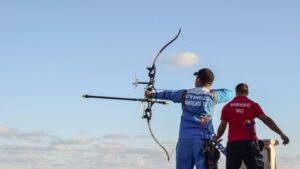
Archery has a wide range of terms and definitions.
Because it has been a weapon of war, hunting weapon and a sport for thousands of years, archery has its own unique language and abbreviations.
Here is a list and glossary of archery terms.
AMO Speed Rating.
The AMO (Archery Manufacturers Organization) method, is a way of rating a bow. The arrow shot is measured in feet per second. It uses a 60 lbs. bow with 30 inch draw length with a 540 grain arrow for the test.
AMO is now called the ATA. (Archery Trade Association.)
The AMO rating shouldn’t be confused with the IBO (International Bowhunting Organization) rating. The IBO uses a 70 lbs. bow draw weight, with a 30 inch draw length and a 350 grain arrow.
For the fastest bows, click on – Fastest Compound Bow Models 2022
Anchor point.
The anchor point is a set spot, which you draw the bowstring to.
The fingers or hand will contact the same spot on the face of the archer. Like the corner of the mouth, check or chin.
A consistent anchor can help the archer shoot more accurately, as the same exact anchor spot is used.
Archer’s paradox.
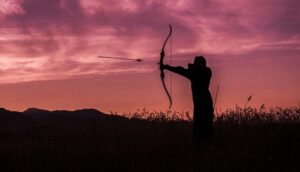
When the arrow is released it flexes from the force of the released bowstring. For non center-shot bows, like longbows and traditional recurve bows, the arrow can bend around the bow riser when released.
Archer’s paradox, or the arrows paradox has the bending during the initial flight.
Armguard.
An armguard protects the bow arm (Arm holding the bow.) from the bowstring hitting your arm. The armguard also stops bulky clothing from interfering with the bowstring.
Arrow length.
The correct way to measure an arrow is from the bottom of arrow nock (Throat of the nock.) to the end of the arrow shaft.
The insert and point are not included in the arrow length measurement.
Arrow nock.
The arrow nock has a groove in it, or split that the bowstring goes in to hold the arrow temporarily.
Arrow rest.
The arrow sits on the rest, while the archer draws the bow. A lot of arrow rest are designed to have minimal contact with the arrow and fletching, so it doesn’t interfere with the accuracy of the bow.
Arrow shaft.
The arrows main long section is called an arrow shaft. The shaft might be made from carbon, aluminum or wood.
Bowfishing arrows are normally made from fiberglass.
Arrowsmith.
Someone who makes the arrowheads, or points of the arrows.
Axle to axle.
This is length of a compound bow. The tip to tip of the wheels or cams are not measured, but measured from the axle to axle.
Barebow.
Barebow refers to the archer not using sights on the bow for aiming.
There are a number of ways to aim the bow, such as gap shooting, point of aim, face walking, string walking and instinctive shooting. Click on How To Aim The Bow And Arrow for more information on barebow shooting and archery aiming methods.
Belly.
The part of the bow or riser that faces you when the bow is held.
Blind.
Cover for hunters and bowhunter for concealment. The hunting blind might be made out of natural foliage like branches, shrubs. Or be a fabric, or camouflage netting material.
Blunt.
A blunt is an arrow tip that is used to stump shoot or hunt small game and has a blunt shape.
Bow stave.
The solid piece of wood, from which the bow is carved or made from.
Bowyer.
A maker of bows. Normally refers to the marker of traditional designed bows like recurves and longbows.
Bow Press.
Used to hold a compound bow, so the limbs are compressed in. The cables or bowstring can removed or the bow worked on, such as insert a peep sight into the bowstring.
Bow Square.
Also called a “T” square, used to measure the bows brace height, tiller, or help adjusting nocking points on the bowstring.
Brace height.
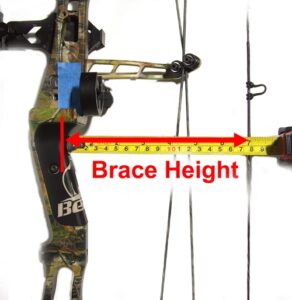
Brace height is measured from the narrowest point of the grip to the bowstring.
Broadhead.
Arrow tips with cutting blades designed for hunting.
Brush button.
Used on the bowstring to question down recurve and longbows. They also prevent foliage from catching between the limbs and bowstring.
Butt.
A target or backstop that catches the arrows in the target.
Cable guard.
A cable guard is used on a compound bow to holds the cables out of the way for the released arrow.
Cable slide.
The cable slide holds the cables and slides along the cable guard.
Camo.
An abbreviation for the word camouflage. Normally used by bowhunters talking about camouflage clothing or equipment.
Center serving.
The center part of the bowstring where the arrow is nocked. The servings is wrapped around the bowstring and helps protect it, and so the arrow nock fits better.
Center shot.
The arrow is directly in line with riser and bowstring.
Cock fletching.
The plastic vane or feather that is normally a different color to the other fleches. Also called an index feather.
This helps index the arrow (Easily recognizable.) on the arrow rest the correct way, so the fletching doesn’t interfere with the arrow rest.
The other two vanes or feathers are often incorrectly called hen fletching, but are called shaft fletching.
Compound bow.
What is a compound bow? A compound bow has cables, wheels or cams.
When the bow is drawn back the cams, or wheels turn over and the archer is only holding a fraction of the weight.
This makes the bow easier for aiming with sights as you don’t have to hold the full draw weight of the bow while also aiming.
Because of the shorter length of a compound bow, the bow is normally used with a release aid device.
A compound bow stores a lot of energy and can generally fire an arrow faster than a longbow or recurve bow. (All things being equal like draw weight, draw length, arrow weight, etc.)
Chronograph.
A shooting chronograph measures the velocity of an arrow or bullet.
Creep.
The archers hand moving forward at full draw, instead of being stationary with the anchor point.
Creep in archery terms can also mean, the bowstring stretches and stays longer.
Cresting.
Arrows with cresting have coloured marking, bands and designs. It was traditionally used to help identify one person’s arrows, from another archer’s arrows.
D loop.
A small piece of cordage used to tie on the bowstring of compound bows. The release aid device then connects on to the d loop directly. Rather than on bowstring which can damage the bowstring.
A d loop might help accuracy and bow tuning, as the release aid is clipped on directly behind the arrow. Interfering less with the release or “loose” of the bowstring.
To learn the correct way to tie a d loop on, click on How To Tie A D Loop.
Draw length.
The distance the archer draws back the bow to their anchor point. The draw length could be for the archer, or the bow.
The draw length is measured from the groove of the nocking point on the bowstring, to the pivot point of the grip. 1 3/4 inches is then added to this measurement, giving the AMO draw length. (Now called the ATA. Archery Trade Association.)
For more information on why the draw length is important visit, How To Measure A Bows Draw Length.
Click on How Figure Out Your Draw Length for more info.
Draw weight.
The amount of force required to draw the bow back to full draw. As an example is, the archer is holding 45 lbs draw weight at full draw.
Dry fire.
Dry firing is releasing the bowstring with no arrow on it. This can be dangerous as it can damage the bows limbs or bowstring.
Field tip.
A field tip or field point is the arrow point that is used for practice, 3D or for field archery. It might be a screw in point for aluminum or carbon arrows. Or be glued on over the tapered end of a wooden arrow.
Fishtailing.
The arrow flexes from side to side when in flight. If it fishtails too excessively it can affect accuracy.
Fistmele.
The traditional way of measuring the brace height on a bow, like a longbow or recurve bow. The fist with the thumb extended out, (Like a thumbs up gesture.) was a recommended height for brace height.
FITA.
French for the Fédération Internationale de Tir à l’Arc. Which is a controlling body for target archery.
FITA is now called the World Archery Federation.
Fletch.
To put feathers or plastic vanes on the arrow.
Fletching.
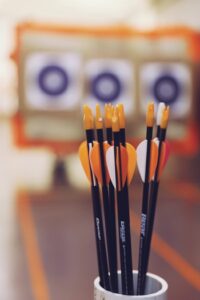
The feathers or plastic vanes that are on the end of the arrow shaft that helps control the arrow in flight.
Fletching jig.
A tool used to hold the feathers or plastic vanes to an arrow, while they are being glued on. The jig also helps evenly place the fletching on the arrow.
Fletcher.
A person who makes arrows.
Flu Flu.
A flu flu arrow is used to shoot small game or birds high up. The fletching is wrapped around the arrow and helps slows the arrow down.
Flu flu arrows can also be used for tricks shots and aerial targets.
FOC.
FOC stands for front of center in archery terms. It is where the balance point is on an arrow. If a heavy point is used then the FOC will be different percentage, compared to a lighter arrow point.
FPS.
The speed of an arrow is measured in feet per second through a shooting chronograph.
Gold.
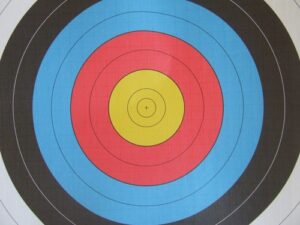
The center of an archery target is called the gold.
It is worth ten points for scoring in the very center ring and nine points for the ring next to it. The color might be a yellow, or gold for these scoring zones.
Historically, the term “gold” was more of a correct term, when an archer shot into the center of the target, rather than the word, “bullseye.”
Grain.
The unit of measurement used to weigh arrow and points in archery.
GPI.
Arrows can be measured as the total weight of the whole arrow, or weighed as per GPI, or grains per inch.
Helical.
The fletching of an arrow might be in a curved helical pattern. This helps spin and stabilize the arrow in flight.
Fletching can be put on straight, offset or helical on an arrow.
IBO bow speed rating.
Testing standards for the IBO (International Bowhunting Organization) is measured in feet per second to see how fast a bow shoots.
The IBO uses a 70 lbs. draw weight, 350 grain arrow and a 30 inch draw length for the test.
Insert.
An insert is placed in the arrow shaft. This helps different points to be swapped and changed on the arrow. Such as field points, blunts and broadheads can then be screwed in the arrow.
Judo point.
An arrow tip that is blunt and has wires to catch the foliage, so the arrow doesn’t get lost easy. It is designed for small game hunting or stump shooting.
Kinetic energy.
Kinetic energy measures the energy of an object moving. Used in bowhunting terms to measure how effective the bow and arrow set up is.
Kisser button.
A kisser button is placed on the bowstring to help get a consistent draw and anchor point on the lips.
Nocking point.
The position on the bowstring where the arrow is located. A nock set or d loop can help position the nocking point.
To see the wide variety of ways the nocking point can be set up on the bowstring visit, Nocking Points And D Loops.
Nock set.
Normally a small brass or metal clamp the goes on the bowstring to position the arrow.
It helps the nocking point be consistent and from the arrow moving on the string. A nock set might also be called a “noc,” or “noc set.”
A nock set might also be tied onto the bowstring with cotton.
Olympic Recurve
Olympic archers use a recurve bow with bow sights and use a finger release. They can use a long stabilizer to help the bow.
The bow and sport is sometimes referred to as “Oly” short for the Olympics.
Compound bows aren’t allowed to be used in the Olympics. With the exception of the 2020 / 2021 Tokyo Olympic Games were the compound bow will be trialed.
Peep sight.
A peep sight goes on the bowstring to help with aiming.
It is a small, normally round item that has a hole in it. This hole is looked though and aligned with the front bow sight on the riser.
A peep sight is similar to aiming with a front and rear sight on a rifle with iron sights.
The peep sight is normally use by compound bow archers with sights.
Olympic recurve target archers are not allowed to use a peep sight. Traditional archers using a longbow or recurve, don’t normally use sights, so no peep sight is not used.
Compound target archers use a peep sight with a small aperture for more accuracy.
Bowhunters might use a larger holed peep sight to let more light in when bowhunting in low light. Like at dusk or dawn.
Porpoising.
The arrow flexes similar to fish tailing, but flexes up and down. This also can affect accuracy.
Power stroke.
Means the length of the bowstring is drawn back and how far the string can travel giving energy to the arrow. A short 25” draw length of an archer won’t have the same power stroke as a tall archer who has a 32” draw length.
Quiver.
The quiver holds the arrows for the archer when walking, or shooting. There are several types of arrow quivers, which should hold the arrows safely and conveniently.
A bow quiver attaches to the bow and has a protective hood to help hold broadheads safely. The bow quiver is popular with compound bowhunters.
A thigh or hip quiver might be used by target archers. This type of quiver is hung of the archer’s belt.
A back quiver is more of a traditional quiver that is slung over the back when bowhunting.
Release aid.
A release aid is a mechanical device that clips onto the bowstring or d loop. Most release aids, have a type of trigger that will release the bowstring more accurately than with fingers.
The release aid device is normally used by compound bow archers, as the short axle to axle design can pinch the archer’s fingers.
Recurve bow.
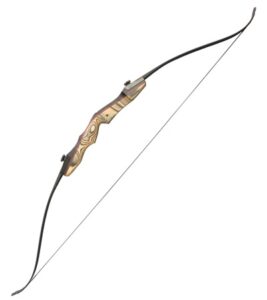
The limbs are designed to bend or curve away from the archer. A recurve bow might be more efficient at storing energy, than a longbow. (All things being equal.)
Robin hood.
Used to describe one arrow hitting the end of another arrow and staying stuck into it, or splitting it down the centre. The first arrow ideally should be in the centre of the target or in the gold.
Shelf.
Traditional bows may have a shelf where the arrow rests. The shelf is cut out from the riser. As opposed to a modern arrow rest, which is separate and attached to the bow.
Shoot through arrow rest.
This arrow rest might be a whisker biscuit type of arrow rest. The actual arrow vanes might go through the rest when the arrow is released.
Spine.
The arrow spine is a measurement of how much the arrow will flex or bend when being fired from the bow.
Arrow manufactures have a spine chart to match the arrow’s spine, safely to the draw weight of the bow. Other factors involved are the point weight, length of the arrow, the bows efficiency and if the arrow will be released with fingers or a release aid device.
Stabilizer.
A stabilizer is placed on the bow to help steady the bow when aiming and reducing torque. It is normal screwed onto the bow’s riser.
A target archer might have a very long bow stabilizer.
A bow hunter might use a shorter bow stabilizer which also helps reduce the bows noise and vibration.
Stump shooting.
Stump shooting is practicing archery in the woods or a field. Where the archer wonders around and shooting at targets, like a leaf, clump of grass, or soft rotted stump. The distance is unmarked.
Tab.
A shooting tab is a piece of material like leather, which the archers use to protect their fingers from the bowstring.
Tiller.
A measurement from the bowstring to the base of the bows limbs.
The top limb tiller measurement might be slightly different to the bottom limb measurement.
Torque.
The hand grip pressure that twist the bow when aiming and releasing the arrow, thus effecting accuracy.
Target archers try to minimise torque by using wrist sling, or a finger sling to help accuracy.
Bowhunters might use a bow sling. This attaches from the bow and goes over the wrist.
True draw length.
This is the measurement from the deepest part of the bow grip to the bowstring when the bow is drawn. (With the AMO method, the 1 ¾” is added on to the measurement.)
Valley.
For compound bows, when you draw back the bow, the cams turn over and reach peak weight, then let down and the archer is holding less weight. This section of the draw length is the valley.
If the archer draws any further with a compound bow, they will hit the wall.
The valley of the compound bow should match the archers draw length. Otherwise the archer will have bad form trying to fit to the bow.
Wall.
A wall is the mechanical stop, where you can’t pull a compound bow back any further. The wall might be a very hard stop, or has a slight give in it.
This glossary of archery terms will be added to as time goes on. Thank you for viewing the article.
